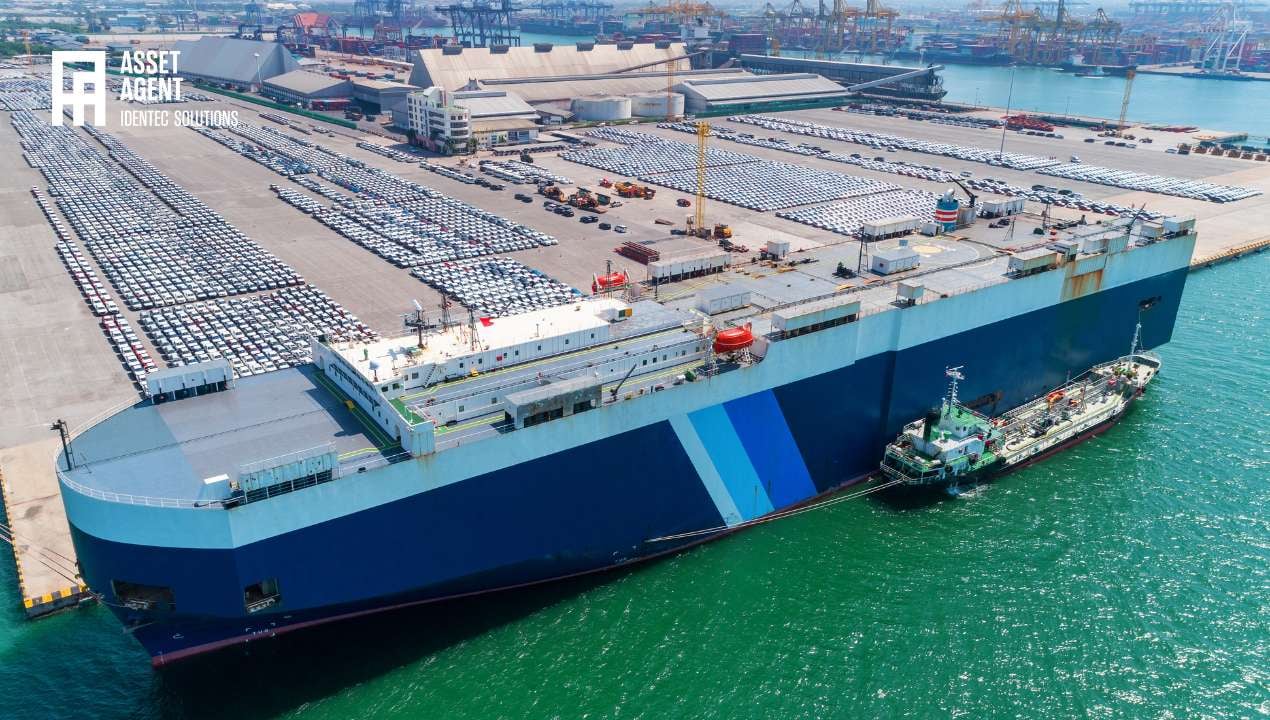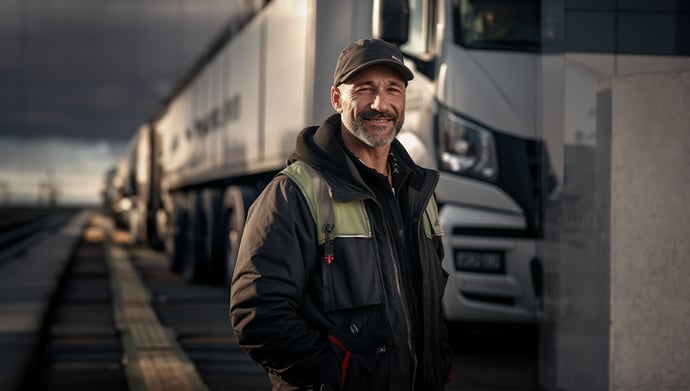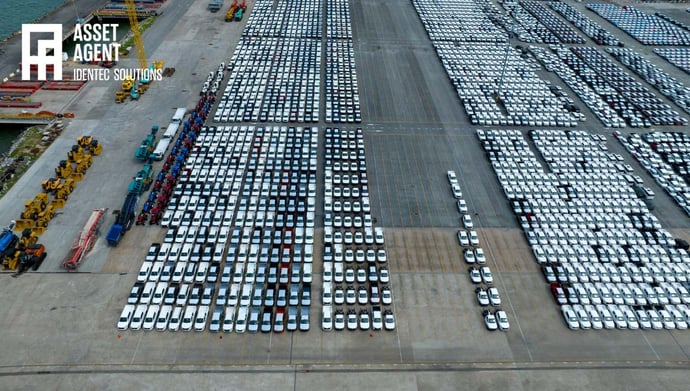RoRo car operations: Support your loading processes
| Written by Mark Buzinkay

No video selected
Select a video type in the sidebar.
What are RoRo vessels?
Roll-on, Roll-off (RoRo) allows goods to roll on and off the vessel, as opposed to being lifted onboard using cranes (like bulk or containers). Self-propelled products, such as cars and trucks, roll on and off the vessel on their own wheels. Products that are not self-propelled are put on handling equipment with wheels in the terminal to be pulled on and off the vessel. The goods thus remain on the handling equipment for the entire sea voyage.
Loading and discharge happen via a wide stern ramp. The ramp capacity on vessels can be up to 500 tonnes. In contrast, most RoRo carriers have ramp capacities of around 150 tonnes. Shipping goods the RoRo way is a secure and efficient process as less lifting is required, and loading is not weather-dependent.
Benefits of RoRo car operations versus containers
One of the often overlooked key advantages of RoRo transport is its cost-effectiveness. Compared to other shipping methods, such as container car shipping, Roll-on/Roll-off offers a more economical transport solution, especially for transporting multiple vehicles or operational fleets.
The streamlined loading and unloading process also reduces labour costs and lessens cargo handling. They minimise equipment requirements and associated labour costs by eliminating the need for cranes or other heavy machinery typically used in heavy cargo handling. This efficient utilisation of resources contributes to a more economical and cost-effective transportation solution.
Moreover, Ro-Ro cargo offers ease and efficiency in the transportation process. As vehicles can be directly driven onto the vessel, it eliminates the need for disassembly or additional packing. This approach is particularly suitable for transporting vehicles that are fully functional and ready to use. Furthermore, the absence of containers and the wide stern ramp provide ample space to accommodate bigger vehicles, such as industrial vehicles, buses, or heavy machinery.
How do we ensure optimised operational handling?
A car carrier is a vessel with a capacity of several thousand cars (CEU, car equivalent unit). The process of loading and unloading cars is fast-forward but needs good preparation. A car carrier has several decks (more than ten is not unusual) of different heights. For a safe load balance and optimal use of space, proper load planning by the loading master is essential. This plan specifies where each car should be placed on the vessel, taking into account factors like weight distribution and destination port. The plan is crucial for both safety and efficiency.
Once the planning is concluded and the vessel is ready for loading, a team of dozens of specialised drivers (stevedores) will start the transfer of cars from the parking space of the automotive port into the interior of the RoRo ship. Drivers are typically well-trained and experienced in these operations. They understand how to manoeuvre vehicles in tight spaces and are familiar with the layout of car carriers. Drivers are briefed on safety protocols, and there are usually staff members on board to guide them and ensure that all operations are carried out safely. But how do they know where to go? The drivers of the cars receive instructions based on the loading plan. This communication can happen in several ways:
- Physical Loading Sheet: Drivers might be given a physical loading sheet outlining which cars to drive and where they should be parked on the vessel.
- Verbal Instructions: Sometimes, instructions are given verbally by supervisors or team leaders coordinating the loading process on the ground.
- Electronic Devices: In more technologically advanced setups, drivers might receive instructions via handheld electronic devices or smartphones linked to the central loading system. These systems not only indicate the pick-up location and the destination of the specified car but also record the time, driver, and performed activity for quality documentation, claim handling and process improvement analysis. Additionally, it updates the car's status (e.g. 'loaded on the vessel').
But one crucial thing is missing: Which car(s) should you load? Cars are usually identified by their VIN (Vehicle Identification Number) or a specific loading number assigned for the operation. This helps drivers ensure they are picking up the correct vehicle. Some car terminal operators use QR codes behind the windshields to identify the vehicle, and some even operate RFID-based transponders with pick-by-light functionality to optimise their process.
Once on board, the car carrier often has marked lanes and designated areas for different types of vehicles. Drivers follow these markings, which align with the loading plan, to park the cars in their assigned spots.
The lashing crew's role in the loading process of a car carrier vessel is essential for ensuring the safety and security of the vehicles during transit. When the cars are driven onboard and positioned according to the loading plan, the lashing crew secures them.
Initially, the crew takes charge of the vehicles from the drivers. A team leader or supervisor often coordinates this transfer and confirms that each car is correctly parked and ready for lashing. Before starting the lashing process, the crew inspects each vehicle to verify its position and checks for any existing damage. They also ensure the handbrake is engaged and the car is in the correct gear, typically 'park' for automatic transmissions.
The lashing process involves using various materials such as straps, chains, and tensioners. The choice of these materials depends on the ship's equipment and the specific needs of different vehicle types. The crew primarily aims to secure the vehicles so they do not move during the voyage. This is achieved by attaching the lashing materials to the wheels or axles of the cars and then to the ship's deck. Ensuring that these lashings are tensioned correctly is a critical step, as improper tensioning can lead to the movement of vehicles and potential damage. The angles at which the lashings are applied are also crucial, as incorrect angles can diminish the effectiveness of the lashings.
Throughout this process, the lashing crew must adhere to strict safety standards and maritime regulations regarding the securement of cargo. For the crew's protection, appropriate safety gear, such as helmets, gloves, and safety shoes, is mandatory. After all the vehicles are secured, a final inspection is conducted to confirm that everything is safely in place, with any necessary adjustments being made at this stage.
The lashing crew may also be responsible for documenting the lashing process, noting any specific arrangements or peculiarities for certain vehicles. Their expertise and efficiency are critical to the safe transport of vehicles, ensuring they remain stationary and secure throughout the voyage, regardless of sea conditions. Loading a vessel this way is very fast - 7 hours to load 1000 cars is a good average.
When the car carrier reaches its destination, the unloading process follows the reverse process. It includes undergoing inspections for transport damages. Once cleared, the car is prepped for its final journey to the customer. These preparations include fueling, washing, tire changes, and, very often, customisation works.
The entire unloading process faces the same operational challenge: How do we make it cost-efficient without risking hurting quality and reputation? Digital tracking and managing car operations out of the vessel and within the car terminal can be a solution.
FAQs
What safety measures are in place during the loading and unloading of cars in RoRo operations?
Safety is a top priority in RoRo cargo operations. During loading and unloading, each vehicle's handbrake is engaged, and it's set in the correct gear, typically 'park' for automatic transmissions. Specialised drivers, known as stevedores, are well-trained in manoeuvring vehicles in tight spaces on the ship. The entire process is supervised by experienced personnel to ensure adherence to safety protocols. Additionally, the lashing crew secures each vehicle with materials like straps and chains to prevent movement during transit, further ensuring the safety of the cargo.
How is the loading process organised in RoRo car operations?
The loading process in RoRo car operations is meticulously planned and executed. A loading master prepares a detailed plan that specifies the placement of each car on the vessel, considering factors like weight distribution and destination port. Drivers receive instructions via physical loading sheets, verbal guidance, or electronic devices, ensuring they know exactly where to drive and park each vehicle. The cars are usually identified by their VIN (Vehicle Identification Number) or a specific loading number, ensuring the correct vehicle is loaded. This systematic approach ensures efficient use of space and safety.
What are the key advantages of using RoRo operations for car shipping compared to container shipping?
RoRo operations offer several advantages over traditional container shipping for cars. Firstly, it's more cost-effective, especially for transporting multiple vehicles or operational fleets, due to the streamlined loading and unloading process, which reduces labour costs. There's no need for cranes or other heavy machinery, minimising equipment requirements and associated expenses. RoRo also provides ease and efficiency, as vehicles can be driven directly onto the vessel, eliminating the need for disassembly or additional packing. This method is particularly suitable for transporting operational, ready-to-use vehicles.
Takeaway
In summary, RoRo operations stand out as a streamlined and economical choice for vehicle transportation, enhanced significantly by digital support. The integration of digital tools in RoRo processes simplifies the complex logistics of loading and unloading, ensuring precise and efficient handling. With the aid of technology, tracking and managing the movement of vehicles becomes more accurate and less labour-intensive, adding an extra layer of efficiency and safety. This digital edge, combined with the intrinsic benefits of RoRo – such as direct driving onto the vessel and reduced need for heavy lifting equipment – culminates in a superior shipping solution that is both time-saving and cost-effective.
Glossary
Labour costs represent the total expenses incurred by an employer to compensate employees for their work. This includes wages, salaries, bonuses, benefits (e.g., health insurance, pensions), payroll taxes, and other related costs. Labour costs are a key component of production and operating expenses, influencing pricing, profitability, and competitiveness. Efficient labour cost management is vital for organizational sustainability and strategic planning. (2)
Reference:
(1) https://www.ecgassociation.eu/
(2) International Labour Organization (ILO). (2008). Global Wage Report 2008/09: Minimum wages and collective bargaining. Geneva: ILO.
Note: This article was updated on the 26th of March 2025

Author
Mark Buzinkay, Head of Marketing
Mark Buzinkay holds a PhD in Virtual Anthropology, a Master in Business Administration (Telecommunications Mgmt), a Master of Science in Information Management and a Master of Arts in History, Sociology and Philosophy. Mark spent most of his professional career developing and creating business ideas - from a marketing, organisational and process point of view. He is fascinated by the digital transformation of industries, especially manufacturing and logistics. Mark writes mainly about Industry 4.0, maritime logistics, process and change management, innovations onshore and offshore, and the digital transformation in general.
Related Articles
Related Product


